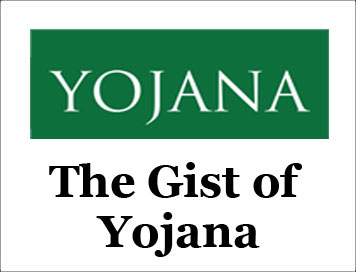(HOT) UPSC Current Affairs 2025 PDF
NEW! The Gist (OCT-2025) | E-BOOKS
(GIST OF YOJANA) ROADMAP FOR VIKSIT BHARAT@2047
GIST OF YOJANA : ROADMAP FOR VIKSIT BHARAT@2047
MARCH-2025
ROADMAP FOR VIKSIT BHARAT@2047
Introduction
The Viksit Bharat@2047 vision charts India’s course toward achieving developed nation status by the centenary of its independence. This vision is fueled by economic resilience, innovation, sustainability, and inclusiveness. The economic reforms of 1991 established the groundwork for India’s swift ascent by eliminating protectionist measures and integrating the country into global markets. Nevertheless, the global economy is experiencing a structural transformation due to protectionism, geopolitical friction, and realigned supply chains. India must adjust its economic strategies to maintain robust growth, foster employment, and create a strong industrial and technological framework while tackling issues such as climate change and the energy transition.
Key Foundations for Viksit Bharat@2047
Realizing the Viksit Bharat aspiration necessitates a self-sufficient growth strategy that zeroes in on four critical priorities:
-
Widespread deregulation
-
Establishing a formidable manufacturing base
-
A sustainable and pragmatic energy transition
-
A joint partnership between the government, private sector, and educational institutions
-
These priorities will empower India to leverage its advantages and maneuver through challenges in an evolving global landscape.
Foundation 1: Deregulation for Advancement
(i) Significance of Deregulation
-
Impact of 1991 Reforms: The abolishment of the License Raj and trade liberalization spurred swift economic advancement.
-
Recent Deregulation Initiatives: Since 2014, the government has implemented significant regulatory simplifications: Streamlined over 20,000 compliances and simplified over 300 laws.
-
GST & Insolvency and Bankruptcy Code (IBC): Optimized tax structure and corporate restructuring.
-
Real Estate Regulation Act (RERA): Refined real estate markets.
-
India Stack (UID-UPI-DBT): Enhanced digital governance and minimized inefficiencies.
(ii) The Necessity for Ongoing Deregulation
Insights from the Economic Survey 2024-25:
-
SMEs lose 50% of industrial plot space due to inflexible building codes.
-
Inflexible labor regulations hinder adaptable working hours, negatively affecting businesses.
-
Obstacles in the education sector (UGC & AICTE regulations) limit dynamic curriculum changes.
Way Forward
-
State-Level Deregulation: Regions with better ease of doing business ratings have demonstrated increased industrial activity.
Reforming Investment Policies:
-
Simplified Income Tax Act and investor-friendly bilateral agreements.
-
A High-Level Committee for Regulatory Reforms to review non-financial regulations.
-
Global Competitiveness: Flexible regulations will attract foreign investments, bolster domestic industries, and promote job creation.
Foundation 2: Manufacturing as a Catalyst
(i) Historical Importance of Manufacturing
Global Insights:
-
Industrial Revolution (UK, 19th century) → Generated major employment opportunities.
-
East Asian Miracle (1970s-2000s) → Nations like China and South Korea used manufacturing as a pathway to alleviate poverty for millions.
-
China’s Manufacturing Supremacy:
-
2000: 6% share in global manufacturing.
-
2024: 45% share, overtaking the US and its allies.
(ii) India’s Manufacturing Blueprint
-
Job Creation: India needs to generate 8 million non-agricultural jobs each year until 2036.
Key Manufacturing Drivers:
-
Production-Linked Incentive (PLI) Schemes:
-
White Goods: Developed a self-sufficient air conditioner supply chain.
-
Telecom Sector: Achieved 60% import substitution.
-
Green Energy Manufacturing: Solar, battery storage, EVs.
Strengthening MSMEs:
-
Trade Receivables Discounting System (TReDS) has enabled ₹1.38 lakh crore in financing.
-
Mutual Credit Guarantee Scheme: Provides a 60% credit guarantee for MSMEs acquiring machinery.
-
Foundation 3: Energy Transition for Economic Resilience
(i) Global Energy Transition Hurdles
Errors by Western Nations:
-
Excessive reliance on renewable energy subsidies resulted in increased energy costs and deindustrialization.
-
Europe’s energy crisis revealed the dangers of rushed fossil fuel phase-outs.
(ii) India’s Distinct Energy Requirements
-
Energy Security & Advancement: India’s industrial growth necessitates affordable and plentiful energy.
Current Energy Transition Objectives:
-
Net-zero by 2070 with gradual decarbonization.
-
Nuclear Energy Expansion: Aiming for 100 GW capacity by 2047.
-
Renewables Growth: Focus on solar, wind, and green hydrogen.
Government Initiatives:
-
Encouragement of private sector involvement in nuclear energy.
-
Changes to nuclear legislation for international technology partnerships.
-
LiFE (Lifestyle for Environment) campaign advocating sustainable consumption.
(iii) Ensuring a Practical Transition
-
Avoiding Premature Fossil Fuel Phase-Out:
-
A gradual transition to renewables without jeopardizing energy reliability.
-
Investment in Green Infrastructure: Enhancing energy-efficient public transportation and circular economy models.
Foundation 4: A Collaborative Compact for Innovation & Growth
(i) Significance of Government-Industry-Academia Collaboration
-
A sustainable growth model hinges on a solid partnership among the government, the private sector, and academic institutions to stimulate:
-
Policy Creativity: Regulatory flexibility and business-friendly frameworks.
-
Skill Advancement: Industry-focused educational reforms.
-
R&D Funding: Technology and AI-driven industrial growth.
(ii) Global Examples & India’s Strategy
-
South Korea’s Innovation Network: Strong ties between government and industry in tech development.
-
Germany’s Vocational Training Approach: Emphasis on industry-oriented education.
India’s Strategy:
-
Startup India & Atal Innovation Mission promoting entrepreneurship.
-
Empowering the National Research Foundation (NRF) to boost R&D.
-
Collaborative research endeavors between universities and industries.
Conclusion
India’s pathway to Viksit Bharat@2047 is anchored in economic resilience, manufacturing capabilities, strategic energy transition, and innovation-led growth. The nation must transform its economic strategies, bolster domestic industries, and adapt to global shifts. The fourfold approach—deregulation, manufacturing advancement, pragmatic energy strategies, and collaborative partnerships—will ensure India evolves into a developed, self-reliant, and globally competitive economy.
CLICK HERE TO DOWNLOAD FULL PDF
CLICK HERE TO DOWNLOAD UPSC E-BOOKS
Study Material for UPSC General Studies Pre Cum Mains
Get The Gist 1 Year Subscription Online
Click Here to Download More Free Sample Material
<<Go Back To Main Page
Courtesy: Yojana



